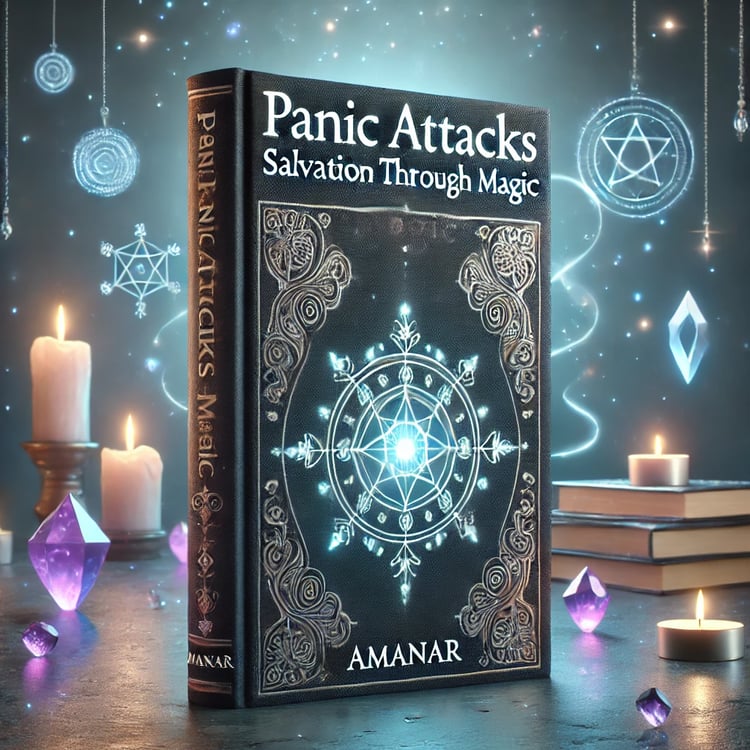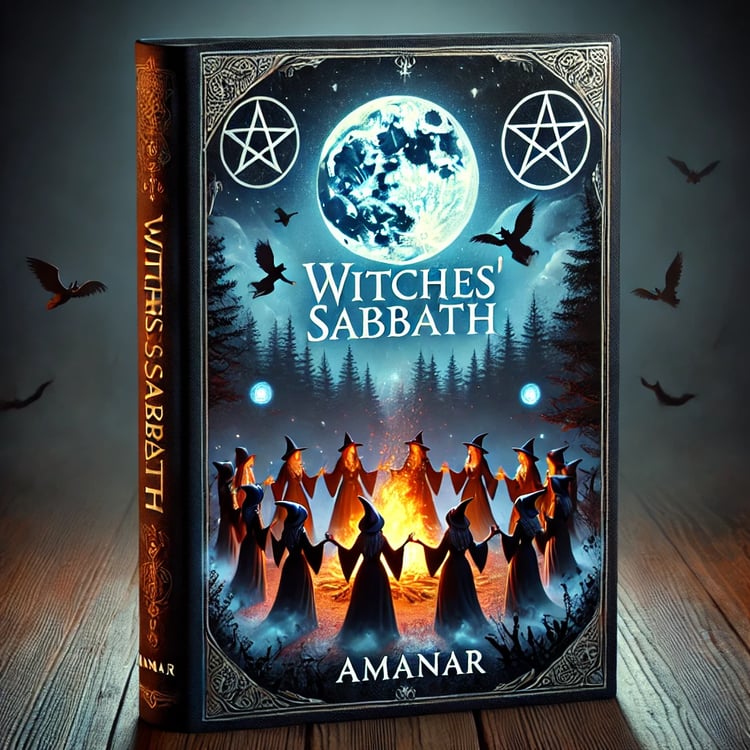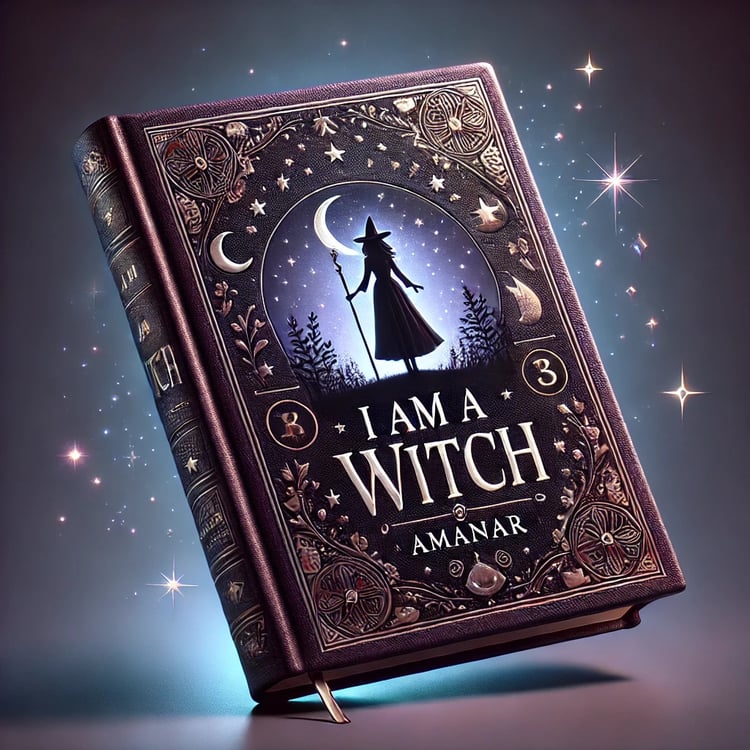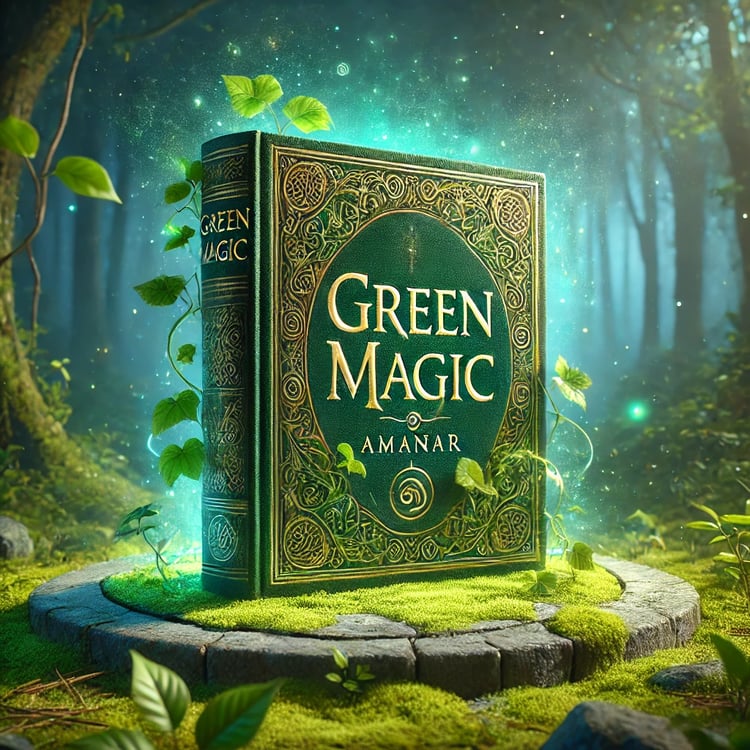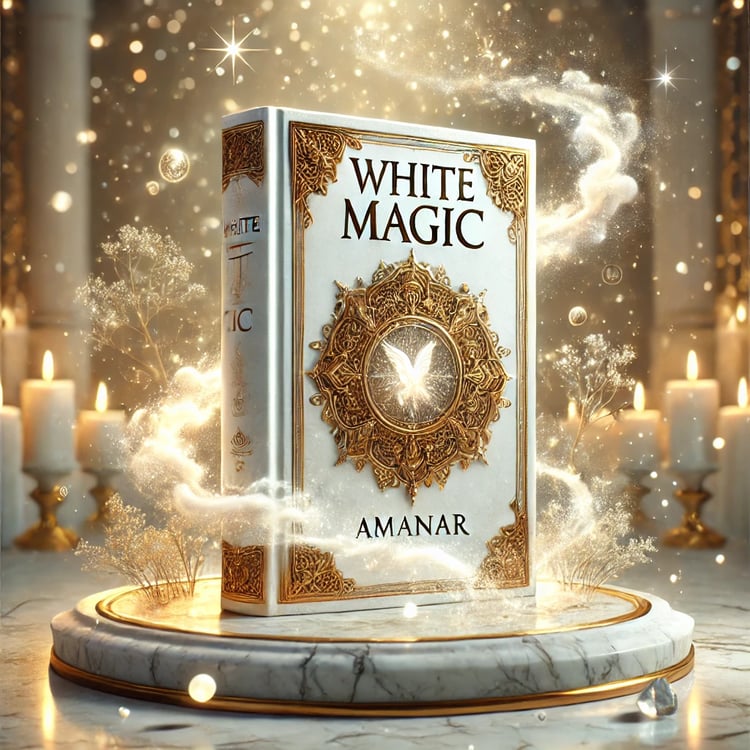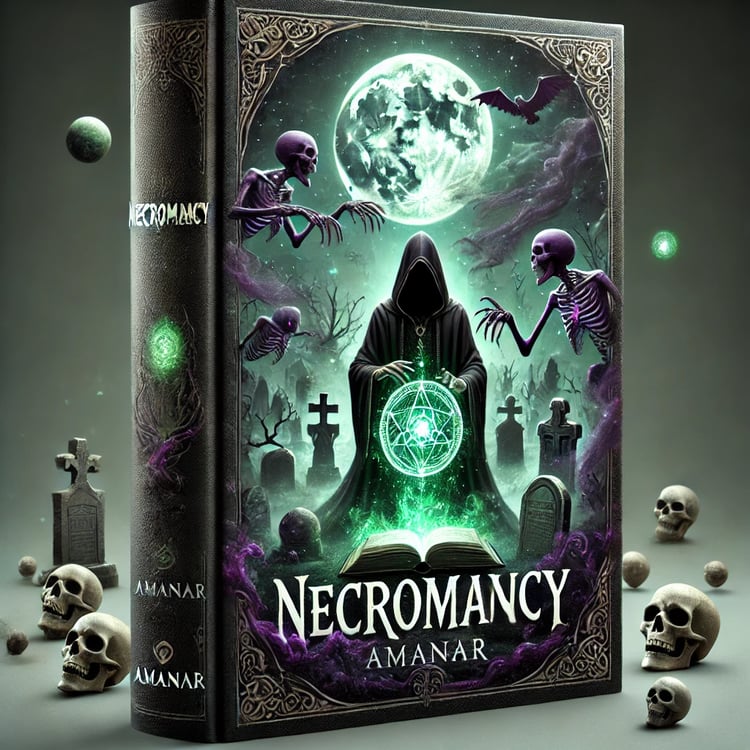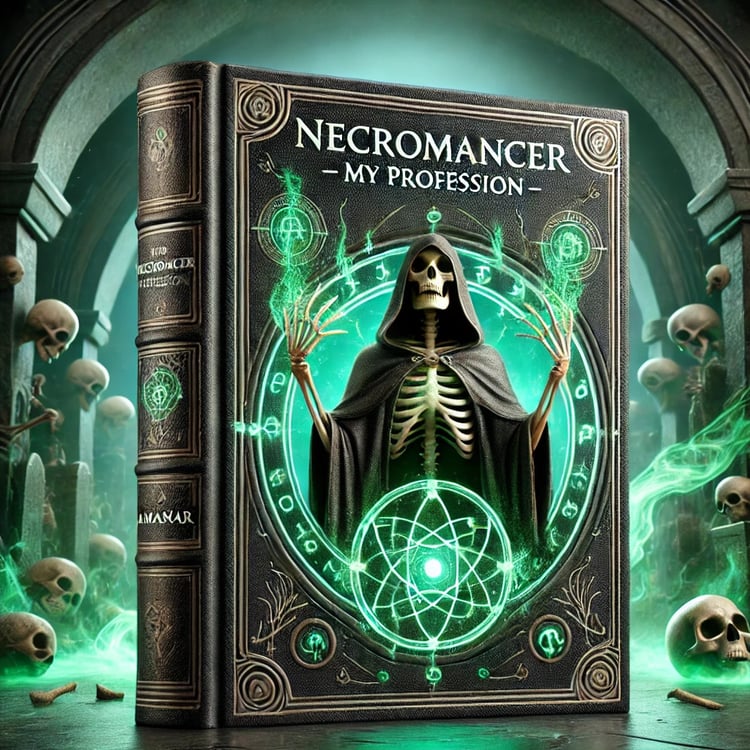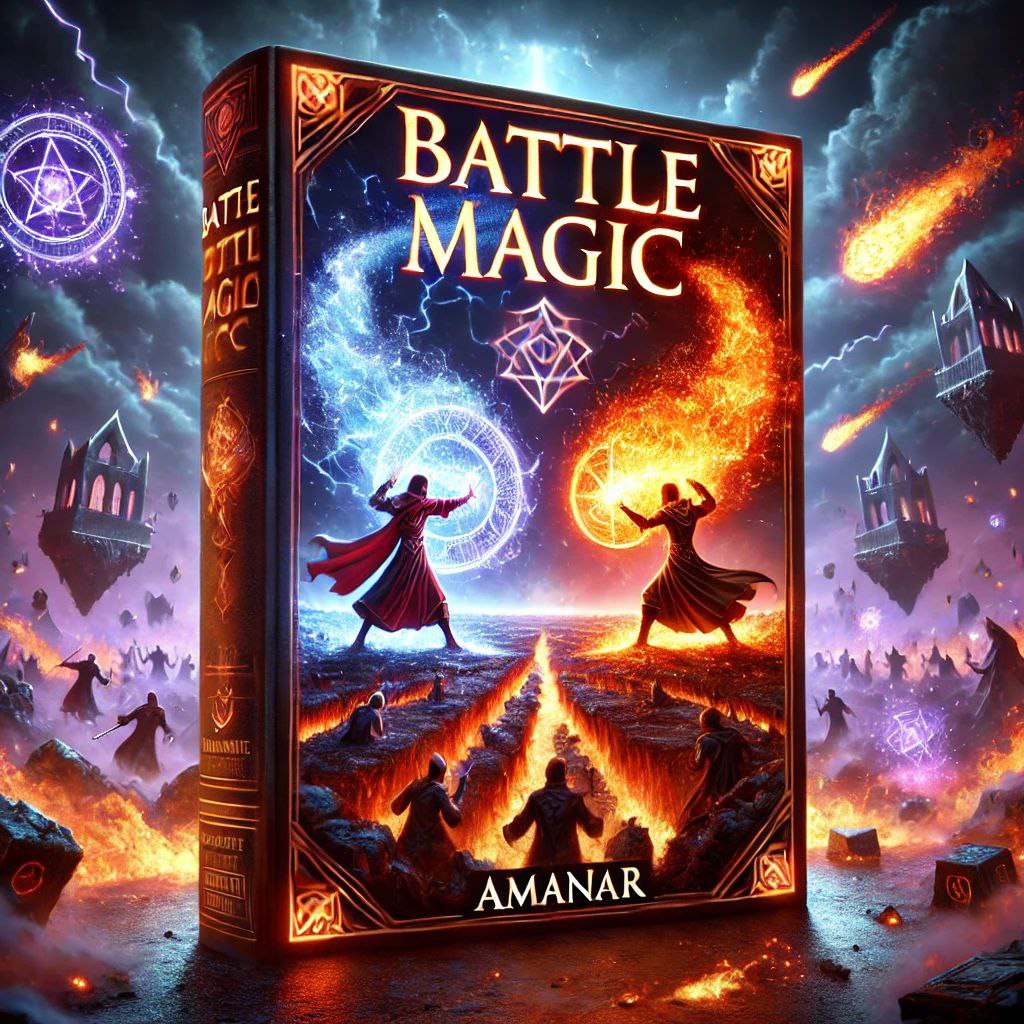
Amanar "Battle magic"
Table of Contents
Chapter 1. Introduction to Battle Magic
1.1. Origins and evolution of magical traditions
1.2. The concept of “battle magic” in the context of occult sciences
1.3. The difference between battle and peaceful practices: a historical and cultural overview
1.3.1. Ancient cults and priestly castes
1.3.2. The influence of the Middle Ages on the formation of battle magic
1.4. Ethical aspects of employing battle magic
1.4.1. The magician’s responsibility to the community
1.4.2. Forbidden practices and their consequences
Chapter 2. The Magical Space and the Sorcerer’s Tools
2.1. Creating and consecrating the sacred circle
2.1.1. Mythological roots of the circle in various traditions
2.1.2. Materials and methods of drawing a ritual circle
2.2. The sword, wand, chalice, pentacle, and other attributes
2.2.1. Construction details and methods of crafting
2.2.2. Mystical significance of each item
2.3. Ritual garments and their effect on spell potency
2.3.1. Color scheme and symbolism
2.3.2. Ritual blessing of clothing and weapons
Chapter 3. Foundations of European Witchcraft in Its Battle Aspect
3.1. Witchcraft borrowings and traditional practices
3.1.1. From “herb-craft” to creating battle potions
3.1.2. Ritual dances and their energetic significance
3.2. European demonology and summoning entities for protection
3.2.1. Classification of demons and protective spirits
3.2.2. Contract formulas and conditions for magical pacts
3.3. Forming egregorial alliances
3.3.1. Differences between personal spirits and egregores
3.3.2. Working with collective energy for defense and attack
Chapter 4. Kabbalah: A Practical Approach to Battle Magic
4.1. The Tree of Sefirot and its application in combat operations
4.1.1. The Sefirot Geburah and Tiphereth: their properties and influence on conflict
4.1.2. The practice of “linking” with higher aspects to increase striking power
4.2. Combinations of Divine Names in spellcasting
4.2.1. Methods of constructing “sigils” from sacred letters
4.2.2. Using the Tetragrammaton in protective rituals
4.3. Astrological correspondences in Kabbalistic battle magic
4.3.1. Planetary hours and weekdays for enhancing spells
4.3.2. Employing talismans through Kabbalistic designs
Chapter 5. Scandinavian Battle Magic: Runes and Galdrastafir
5.1. General overview of the Elder Futhark runes
5.1.1. Classification of runes by ætts
5.1.2. Basic principles of rune writing and pronunciation
5.2. Runic magic for defense and offense
5.2.1. Rune combinations for defensive seals
5.2.2. Runic formulas to neutralize an enemy
5.3. Galdrastafir and their battle applications
5.3.1. Creating individualized staves for specific goals
5.3.2. Ritual activation and rules for storage
Chapter 6. Voodoo and Its Rituals of Power
6.1. General notions of the Loa and their spheres of influence
6.1.1. Loa classes: Rada, Petro, Ghede, and others
6.1.2. Specifics of communicating with and making offerings to spirits
6.2. Voodoo dolls and energy manipulation
6.2.1. Creating a doll from natural materials
6.2.2. Strongest incantations and attaching the target’s energy field
6.3. Martial aspects of Voodoo
6.3.1. Ritual dances for warfare
6.3.2. The practice of “zombification” and its real limitations
Chapter 7. Theory and Practice of Latin Incantations
7.1. The origin of Latin formulas in European magic
7.1.1. Latin as the “language of the Church” and “language of secret knowledge”
7.1.2. The fusion of ecclesiastical and occult traditions
7.2. Basic constructions of Latin incantations
7.2.1. Grammatical specifics: the imperative mood
7.2.2. Symbolism in the use of archaic Latin terms
7.3. Sample templates for battle spells in Latin
7.3.1. Defensive: “Praesidium maximum” and its variations
7.3.2. Offensive: “Ignis maledictus” and key elements of construction
Chapter 8. Ceremonial Magic: The Structure and Preparation of Ritual
8.1. The traditions of the Golden Dawn, Thelema, and other schools
8.1.1. Common principles of ceremony design
8.1.2. The placement of magical tools and the altar
8.2. Stages of ritual performance
8.2.1. Clearing the space (banishing) and calling forth (invocation)
8.2.2. Invoking archetypes and the elements
8.3. Closing the circle and “sealing” the result
8.3.1. Sigil formulas and the use of symbols
8.3.2. Thanking the forces and removing protections
Chapter 9. Working with the Elements in Battle Magic
9.1. Elemental forces: Fire, Water, Air, Earth
9.1.1. Methods for determining a magician’s predominant element
9.1.2. Balance among elements and success in combat
9.2. Battle spells based on the elements
9.2.1. Fiery flows and wind vortexes
9.2.2. Water-based strangling waves and Earth-based “quagmires”
9.3. Elemental entities as allies
9.3.1. Salamanders, undines, sylphs, and gnomes
9.3.2. Concluding astral agreements with elemental forces
Chapter 10. Alchemical Aspects of Battle Magic
10.1. The fusion of alchemy and mysticism in warfare
10.1.1. The significance of the “Great Work” in forging weapons
10.1.2. Alchemical processes: calcination, coagulation, solution
10.2. Battle potions and poisons
10.2.1. The use of philosophical sulfur and mercury
10.2.2. Methods of testing safety for the magician himself
10.3. Alchemical seals and metals
10.3.1. Sacred metals and their planetary correspondences
10.3.2. Creating amulets for protection and offense
Chapter 11. Psychic Defense and Influencing the Enemy’s Mind
11.1. Mental shields and their enhancement
11.1.1. Using visualization and breathing techniques
11.1.2. Integrating geometric figures into the astral plane
11.2. Techniques for instilling fear and doubt
11.2.1. Anchoring words and gestures in the subconscious
11.2.2. Creating “pain points” and vulnerabilities for the enemy
11.3. Counteracting hostile suggestions
11.3.1. Anchors of self-confidence and protection
11.3.2. Methods of “cleansing” the mind and heart
Chapter 12. Battle Astral Projection
12.1. The astral plane and its layers
12.1.1. “Lower” and “Higher” astral: differences and dangers
12.1.2. Transition between spheres and points of support
12.2. Astral combats and defense
12.2.1. Forming the “warrior” astral body
12.2.2. A system of sigils and seals against hostile entities
12.3. Returning from the astral and conserving energy
12.3.1. The “retraction” technique
12.3.2. Grounding and reintegration
Chapter 13. Tarot Arcana and Their Role in Battle Rituals
13.1. The Major Arcana system and archetypal images
13.1.1. 22 key forces and their battle interpretation
13.1.2. Combining Major Arcana in protective rites
13.2. Spreads for foreseeing the outcome of combat
13.2.1. Simple three-card spreads
13.2.2. The Celtic Cross for large-scale conflicts
13.3. Charging cards for martial purposes
13.3.1. Aligning energy to a specific spell
13.3.2. Creating “shielding” and “striking” decks
Chapter 14. Group Ritual Techniques and Building a Battle Egregore
14.1. The power of unity: magical synergy in conflict
14.1.1. Roles of participants: priest, circle keeper, attacking magician
14.1.2. Task distribution and circular coordination
14.2. Creating a collective “battle egregore”
14.2.1. Forming a shared intention
14.2.2. Maintaining energy levels among participants
14.3. Methods of sustaining connection over distance
14.3.1. Using astral knots and “magical beacons”
14.3.2. Common ritual closing and group harmonization
Chapter 15. Battle Sigils and Protective Seals
15.1. Principles of graphically encoding intention
15.1.1. Combining geometric and alphabetic symbols
15.1.2. Strengthening a sigil through fire and blood rituals
15.2. Complex sigils: multi-layered structures
15.2.1. Integrating spirit names and astral channels
15.2.2. Working with color and the material of the seal
15.3. Protective circles and seals: differences and usage
15.3.1. Seals for places of power: home, tower, fortress
15.3.2. Personal seals for wearing on the body
Chapter 16. Necromancy and Commanding the Dead for Battle Purposes
16.1. Myths and realities of necromantic practice
16.1.1. The forbidden and taboo aspects of necromancy
16.1.2. The difference between animism and classical necromancy
16.2. Summoning a warrior spirit or an ancestor
16.2.1. Preparations: symbolic items and offerings
16.2.2. Incantation formulas for contacting the afterlife
16.3. Creating and controlling shadow entities
16.3.1. Protective measures when working with otherworldly forces
16.3.2. Releasing or “binding” a spirit to the magician
Chapter 17. Ritual Combat and the Magical Duel
17.1. The magicians’ code of honor for confrontations
17.1.1. Traditions of challenge and accepting a duel
17.1.2. The role of witnesses and “arbiters” in battle rituals
17.2. Structure of a magical duel
17.2.1. Preparing the circle and allocating forces
17.2.2. Transition to the “magical attack” and defense
17.3. Concluding the duel and its aftermath
17.3.1. Cleansing astral injuries
17.3.2. Restoring balance and summing up
Chapter 18. Self-Improvement and Physical Training for the Magician
18.1. The importance of physical fitness in battle magic
18.1.1. Strengthening the body to withstand energy overload
18.1.2. The role of breathing exercises and martial arts (Tai Chi, Capoeira, etc.)
18.2. Psychological training and overcoming fear
18.2.1. Systems of auto-training and meditation
18.2.2. Building “combat consciousness” and vigilance
18.3. The balance of “spirit–body–mind”
18.3.1. “Root” grounding practices
18.3.2. Maintaining a healthy lifestyle as part of magical discipline
Chapter 19. Battle Amulets and Talismans
19.1. Amulets made from natural stones
19.1.1. Choosing the right stone for the task: hematite, obsidian, tiger’s eye
19.1.2. Charging and “awakening” a stone for battle aims
19.2. Metal and wooden talismans
19.2.1. Correlating metals with planets and war gods
19.2.2. Crafting, consecration, and methods of wearing
19.3. Creating a personal battle talisman-beacon
19.3.1. Incorporating runic, Latin, and Kabbalistic symbols
19.3.2. Periodic “recharging” and reinforcement
Chapter 20. The Influence of Planets and Stars on the Outcome of Magical Conflict
20.1. Astrological aspects of strife
20.1.1. Planetary transits and their impact on magical abilities
20.1.2. The “Martian” and “Jovian” aspects in battle magic
20.2. Lunar phases and their correlation with rituals
20.2.1. Full moon rituals for maximum power
20.2.2. Waning moon and its use in subduing the enemy
20.3. Stellar magic and fixed stars
20.3.1. Creating “star portals” in rituals
20.3.2. Harnessing the energy of constellations and their mythological patrons
Chapter 21. Purification Practices After Combat
21.1. The magician’s energetic rehabilitation
21.1.1. Removing negative influences and “lingering scars”
21.1.2. Ritual baths with herbs and minerals
21.2. Working with emotions and reformatting the mental field
21.2.1. Methods to release guilt and bitterness
21.2.2. Restoring harmony through meditations on the ether element
21.3. Renewing contact with Higher Powers
21.3.1. Thanksgiving rites and replenishing one’s “roots”
21.3.2. Integrating the experience of battle rituals into personal magical practice
Chapter 22. Concluding Thoughts and the Magician’s Path
22.1. The point of departure to a new level of consciousness
22.1.1. Synthesizing traditions and past experience
22.1.2. Pathways of further development in battle magic
22.2. The code of honor for a battle magician: principles and ideals
22.2.1. Accountability for the consequences of one’s actions
22.2.2. Valor, wisdom, and compassion as highest values
22.3. Final admonition
22.3.1. The “closing of the book” rite and blessing future endeavors
22.3.2. May the road be bright: magical wishes for the reader
Preface
Every era has left its mark on the history of the magical arts, and not always has that mark been strewn with the petals of peaceful discoveries and benevolent healings. Magic is a multifaceted phenomenon, and its energy can serve both peace and war. From the most ancient times, shamans, priests, sorcerers, and magicians have sought ways to influence the outcome of battles: what we call “battle magic” permeates every continent and culture. Yet the true essence of this profound force is known to few even today.
In this book, titled Battle Magic, I, Amanar, set out to gather the remaining fragments of knowledge scattered among old tomes and passed down orally from generation to generation across various traditions. Much has been lost and buried beneath the sands of time, obliterated by the fires of the Inquisition and political intrigue, dissolved in the fog of superstition and fear. Nevertheless, the living root of battle practices—truly indomitable—revives time and again, slipping through secret societies, orders, and family clans. It returns to remind us of the responsibility that lies upon those who can wield such power.
Battle spells, rituals, and practices form a double helix: on the one hand, they contain the force of great creation; on the other, they can burn to ashes not only the enemy but also the magician themself, if one delves into darker aspects without due comprehension. It is fitting here to recall a well-known saying: “All power without wisdom leads to chaos.” That is why it is so crucial to emphasize that the study of battle magic is not a path taken to gain dominion over others, but a journey toward a profound understanding of oneself and the laws of the universe. Only a conscious magician, aware of the limits of their own soul, can carry this knowledge without turning it into a destructive storm.
In this work, I endeavor to unite the practices that stem from European witchcraft and ceremonial magic with the rituals originating from Kabbalah, Voodoo, and the Scandinavian runic traditions. Each path carries its own unique history, its own spiritual and cultural context, its own heroes and villains. But regardless of how diverse their origins may be, at the core of each system of battle practices lies one irrefutable rule: power comes with responsibility and grows stronger only when the magician’s soul attains maturity.
The immense legacy of occult Europe. We might think that battle magic found its greatest development in Eastern teachings, since legends of Japanese or Tibetan martial techniques abound. But one must not forget the colossal European repository of knowledge. The Middle Ages, with its alchemical laboratories, secret Rosicrucian conventions, and enigmatic gatherings of scholarly monks, was a time not only of witch-hunts but also of the flourishing of mystical schools. Above all, people valued knowledge that could protect castles, kingdoms, and cities. In this context, sophisticated methods of curses were born alongside powerful protective ceremonies. Some say that certain of these practices were transmitted only in a direct lineage from teacher to student, bound by complex vows of silence and strict adherence to specific philosophical principles. Delving into the depths of those rites is no simple task; we only skim the surface in hopes of uncovering the true seed of these traditions.
Kabbalah and its formidable side. When people speak of Kabbalah, they often imagine subtle spiritual practices tied to the Divine Names, the Tree of Sefirot, and contemplating the paths between realms of being. Yet lurking in the shadow of this majestic system is its martial aspect: knowledge of the power of words, the forging of “thunderous” protective formulas, and the use of powerful vibrations from sacred letters. It would be a mistake to think that Kabbalah is merely about transcendental striving for pure Divinity; it holds a formidable arsenal of tools capable, under certain conditions, of shielding the magician—and at times delivering a crushing blow to those who raise a hand against them.
Scandinavian runes stand as a vivid example of how a system of writing can become a source of power. Every symbol of the Futhark is an entire universe of archetypes, capable of invoking the forces of nature and turning them into a shield or spear that strikes at the astral level and can even manifest in the physical realm. By combining runes with galdrastafir, the ancient warriors sought the blessing of their gods and invoked victory and protection in merciless skirmishes. Among these symbols, one finds runes that are aggressive and filled with fire as well as those that grant calm and invulnerability, like an icy armor. Anyone who has mastered at least the basics of runic magic possesses a key to the power of the northern elements, which know no mercy.
Voodoo is a tradition veiled in mystique and fear. To most outsiders, it is associated primarily with sinister dolls and images of zombies. Yet Voodoo is a sophisticated, many-sided system of interaction with the Loa—spirits that can offer both mercy and patronage, as well as harsh punishment. In the hands of a skilled magician, Voodoo rituals become a flickering flame whose sparks dance around the boundary between good and evil. The martial aspect of Voodoo does not necessarily involve mindless harm; rather, it often includes elaborate ceremonies of “just retribution” or the protection of one’s family and land from aggression.
Worthy of particular mention are Latin spells, which, crossing millennia, still preserve their mysterious allure. For centuries, Latin was considered the language of authority—used by rulers, the righteous, and heretics alike, by the Church and secret societies. Stylized Latin phrases give rituals a special solemnity and intensity. Many ancient formulas compiled back in the Middle Ages still evoke reverence and awe in those who dare pronounce them. In some cases, Latin incantations serve as a sort of “universal key” for summoning or dismissing entities, making them an integral part of Western battle-magic tradition.
Yet magic does not exist in a vacuum—it is an extension of the magician, a tool of their will and a reflection of their soul. Hence the book culminates in chapters that address not only specific rituals and systems but also ethical, psychological, and spiritual dimensions. The battle does not begin solely in the external arena but first and foremost within the magician themselves. Banishing fear or doubt, freeing oneself from the evil eye or inner weakness can be just as important as learning the exact words and gestures of spells. Masters of the past knew that victory often depends not on the strength of one’s arm but on the steadiness of one’s spirit and the purity of one’s intent.
Battle Magic is a book that invites the reader to view the art of magical conflict as an integrated practice. From creating a protective circle to orchestrating battle astral projection, from guarding one’s personal energy to engaging in duels where honor and adherence to ritual rules count as much as incantations themselves—every step on this journey requires deep reflection and a willingness to evolve inwardly. By taking up the path of the battle magician, you agree to a perpetual evolution: by refining yourself, you recognize and transform the energy that fills the Universe.
Nevertheless, it must be remembered that magic is no game. Despite its apparent allure, the rites of conflict and attack rest on profound interconnections that transcend conventional notions of cause and effect. A spell you cast might return to you like an energetic boomerang if, at the moment of utterance, your thoughts and emotions were not aligned with cosmic laws. Every ritual is a dialogue with the invisible world. Even battle challenges aimed at defending against aggression are always an interaction with Forces that demand our respect, caution, and understanding of our inner truth.
Before delving into each section of this book, I remind you of the importance of conscious practice. There is no room here for blind obedience to recipes or templates. Rituals are but patterns; a true pattern is always woven anew to suit the individual magician’s energy, their life’s path, and the unique traits of their soul and body. Think of Battle Magic as a compass, not a manifesto. By following this compass, you yourself will mark the stars on your firmament and choose the winds that best accompany you as you draw close to the mystery of your own power.
It is my hope that this book reminds you of the light within, even as you touch upon the shadowy facets of magical warfare. May each line kindle a small flame along the path to the realization that battle magic is not merely a fiery orb in the magician’s hand or a blade charged with runes. It is also a tremendous responsibility, an unshakable moral foundation, and a choice made for the future rather than for idle displays of personal supremacy.
For those who dare step into the world of battle magic, a challenging yet thrilling adventure awaits. May it be illuminated by sparks of wisdom, and may your spirit find balance. May the pages of this book open a door into the enigmatic labyrinth of the true martial mastery of the magician, where the key to every victory lies not only in spells but in the voice of the heart.
In peace and power,
Amanar

